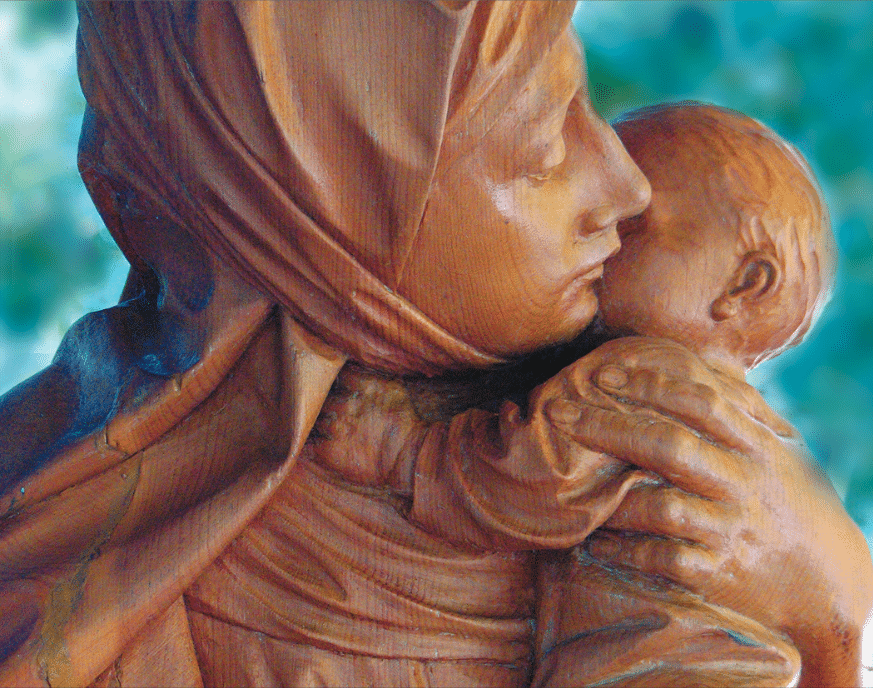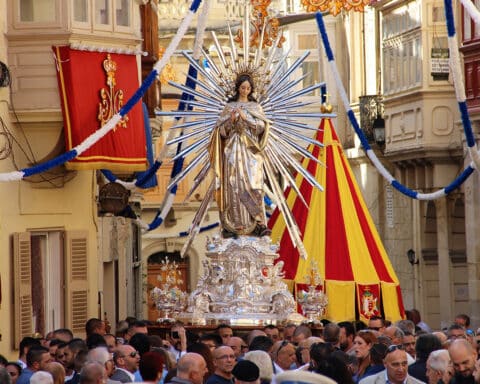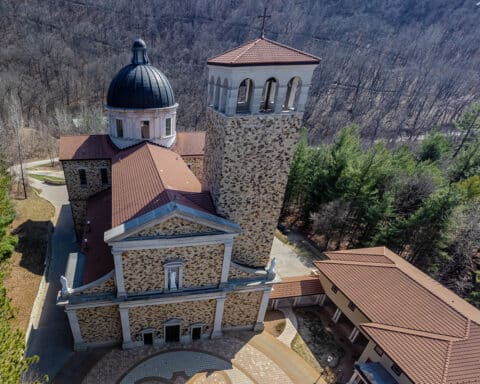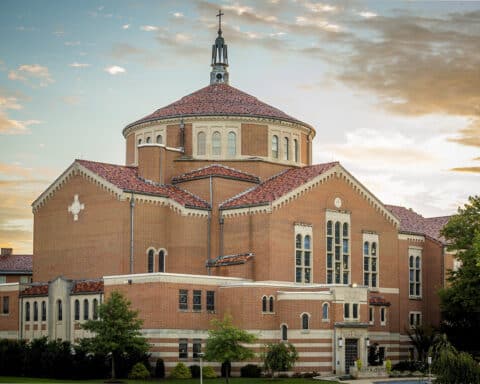To make a pilgrimage to a Marian shrine is a beautiful way to celebrate one’s Catholic faith. Unfortunately, not all people have the time or money to make a pilgrimage to one of the great Marian shrines of the world such as Our Lady of Guadalupe in Mexico, Our Lady of Lourdes in France or Our Lady of Fatima in Portugal. There are, however, numerous Marian shrines of special importance spread throughout the United States. Here are six shrines worth considering.
1. Our Lady of Prompt Succor, New Orleans
The National Shrine of Our Lady of Prompt Succor is located on the campus of the Ursuline Academy of New Orleans. Although the present shrine was consecrated in 1928, its origin goes back to a promise made in 1810 to Our Lady by the Ursuline sister Mother St. Michel Gensoul.
The Ursuline Sisters first came to Louisiana in 1727, and they established Ursuline Academy to educate children of European colonists and the local Creole people whether slave or free. In 1803, Louisiana was purchased by the United States, and President Thomas Jefferson sent a letter to the Ursuline Sisters assuring them that they could retain their property.
The Sisters, though, were short on personnel, and the superior, Mother St. Andre Madier, wrote to her cousin, Mother St. Michel Gensoul, in France asking her to come to New Orleans to help the community. Mother St. Michel asked Bishop Nicolas-Marie Fournier of Montpellier, France, for this permission, but he said only the pope could give this authorization. Pope Pius VII, however, was being held captive by Napoleon during this time, and it was uncertain whether he could be reached to give permission. Mother St. Michel prayed before a statue of Our Lady asking that her request might be received by the pope. If her request was granted, she promised to honor the Blessed Mother under the title of Our Lady of Prompt Succor.
Her request was granted. She sent a letter to Pius VII from Montpellier March 19, 1809. On April 28, a letter from a cardinal authorized by the pope granted permission to go to Louisiana. Mother St. Michel had a statue of Our Lady of Prompt Succor carved, and it was blessed by Bishop Fournier. This statue, along with Mother St. Michel, arrived in Louisiana in 1810.
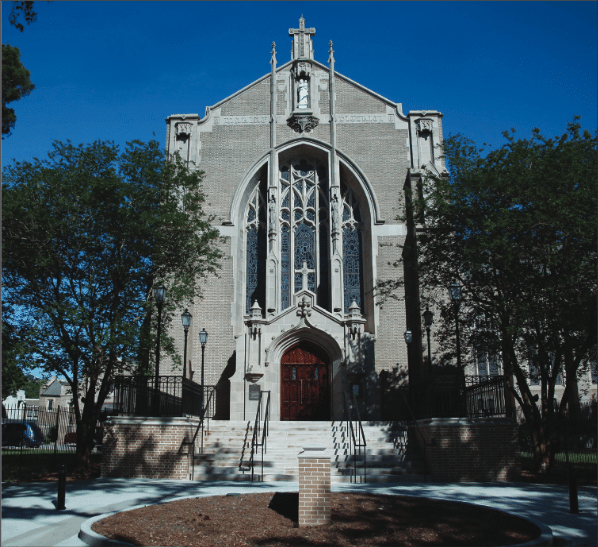
Many miracles and graces have been associated with the statue of Our Lady of Prompt Succor in New Orleans. When a fire raged through the city in 1812, the Ursuline Sisters prayed before the statue and the fire shifted direction. During the War of 1812, the British forces seemed sure to defeat the outnumbered American troops in New Orleans. On the night of Jan. 7, 1815, the Ursuline Sisters prayed before the statue. During Mass the next morning, a courier came in to announce that the American troops under Andrew Jackson had miraculously defeated the British. A fog had moved into the area where the British had lodged, and by mistake, they moved into a swamp where the outnumbered American troops could easily fire upon them. General Jackson, learning of the prayers of the sisters, went to the convent to thank them.
The feast of Our Lady of Prompt Succor is celebrated in New Orleans Jan. 8 in commemoration of her miraculous intervention. Today, the statue is in the beautiful National Votive Shrine of Our Lady of Prompt Succor.
2. The Basilica of the National Shrine of Our Lady of Fatima, Lewiston, New York
In the area around Buffalo, New York, there are two Marian shrines of special importance. Mention should first be made of Our Lady of Victory National Shrine and Basilica in Lackawanna. This is a magnificent European-style basilica that owes its existence to the dedication of Father Nelson Baker (1842-1936) who was granted the title venerable by Benedict XVI in 2011. Completed in 1926 and raised to the status of a basilica that same year, this beautiful Baroque revival church has an interior filled with paintings, mosaics and marble work. This basilica is a fitting testimony to the devotion of Venerable Nelson Baker to Our Lady and to the poor orphans whom he served.
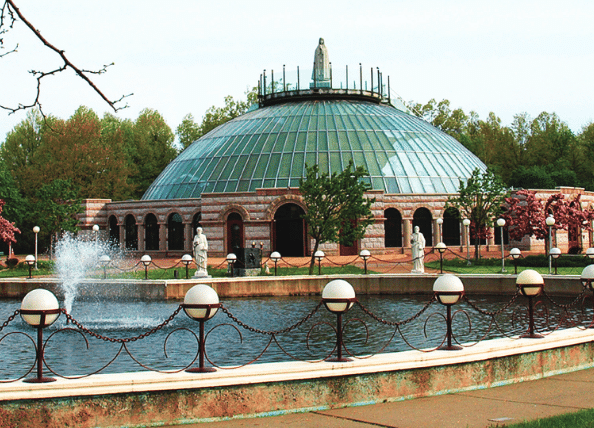
Some 26 miles away is the Basilica of the National Shrine of Our Lady of Fatima in Lewiston, just north of Niagara Falls. The shrine is located on 16 acres of former farmland donated by Mr. and Mrs. Walter Ciurczak in 1954, and it is served by priests of the Clerics Regular of St. Paul — the Barnabites. When Walter Ciurczak had a serious stroke and his wife also fell ill, they prayed to the Blessed Mother and promised to donate a portion of their land to a religious community that would use it in her honor. After they recovered, they were visited by Father Igino Andreani of the Barnabites, and they told him their story. When Father Andreani met a man wanting to donate a statue of Our Lady of Fatima, the idea arose to build a shrine in her honor.
The church was begun in 1961 and dedicated in 1965. In 1975, Blessed Paul VI elevated the church to the status of basilica. The dome of the basilica is 100 feet in diameter and 55 feet high. At the top of the dome, there is a statue of Our Lady of Fatima that is 13 feet high and weighs 10 tons. The main altar in the basilica is made of Italian Carrara marble. In front of the basilica is a giant rosary of 59 lights and a rosary pool shaped like a heart in honor of the Immaculate Heart of Mary.
The grounds of the National Shrine of Our Lady of Fatima are magnificent. In addition to the 48-foot high bell tower, there is a Fatima Hill with a rosary of beads made of authentic cannon balls. These symbolize the need to surrender weapons of war to the Queen of Peace. On the grounds, visitors will find numerous shrines, such as those dedicated to St. Anne, Our Lady of Czestochowa, St. Anthony Maria Zaccaria and St. Padre Pio. There is also the original Our Lady of Fatima Chapel, which served pilgrims until the basilica church was completed in 1965.
3. The Grotto/The National Sanctuary of Our Sorrowful Mother, Portland, Oregon
This shrine came about because of a prayer and a promise made by a young boy from Kitchener, Ontario, in the late 19th century. Ambrose Mayer knew his mother was close to death after giving birth to his younger sister. He prayed fervently for his mother’s life in the nearby parish church, and he promised that he would do something great for the church if his mother and sister survived. His prayers were heard. Both his mother and sister survived, and he never forgot his promise.
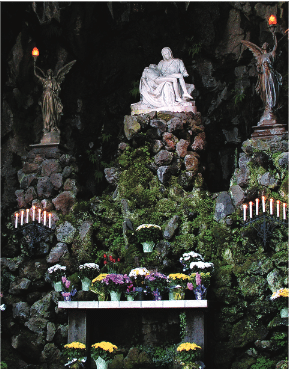
Ambrose later joined the Servite religious order, which is dedicated to the Sorrows of Mary. He eventually was sent to Portland, Oregon, where he became the first Servite pastor in that city. In 1923, Father Mayer found some property for sale on a rugged hilltop location. He saw this as a site for a possible shrine, but the asking price was $48,000. After putting down all he had — $3,000 — as the initial deposit, he began a national campaign to raise funds for the purchase of the land on which he hoped to build a Sanctuary of Our Sorrowful Mother. He wrote to and received a personal letter from Pope Pius XI bestowing a special apostolic blessing upon all those who would contribute toward the building of the envisioned shrine.
Work began on the sanctuary in 1923. A cave was carved out of the side of a basalt cliff over 100 feet high. This became the famous grotto of the sanctuary, with a stone altar and a replica of Michelangelo’s Pietà eventually added. The first Mass and dedication of the Sanctuary of Our Sorrowful Mother took place May 29, 1924, with 3,000 people present along with Archbishop Alexander Christie. The archbishop prayed that the sanctuary would be a place “where the human spirit can seek peace and consolation.” A larger church — the Chapel of Mary, Mother of the Human Race — was built on the grounds and dedicated in 1955. In 1983, the shrine was recognized as a National Sanctuary, and millions of people since have visited this beautiful hilltop shrine, which also has outdoor stations of the Sorrows of Mary.
The Sanctuary of Our Sorrowful Mother was the site of the first Marian Congress ever held in the United States. The congress took place in August 1934 and had an estimated 2,000 to 3,000 people in attendance at each session. At the closing ceremony Aug. 15, 1934, a crowd of at least 20,000 gathered to receive the blessing of Cardinal Alexis-Henri-Marie Lépecier, who consecrated all present to the Blessed Virgin Mary.
4. National Shrine of Our Lady of La Leche, St. Augustine, Florida
The oldest Catholic settlement in what today is the United States is in St. Augustine, Florida, which was founded in 1565. St. Augustine is also the location of the Shrine of Nuestra Señora de la Leche y Buen Parto (“Our Lady of the Milk and Happy Delivery”), which is the first shrine to Our Lady in the United States. It was initially built by the Spanish around 1620, and it is located on the grounds of the Nombre de Dios (Name of God) Mission in St. Augustine.
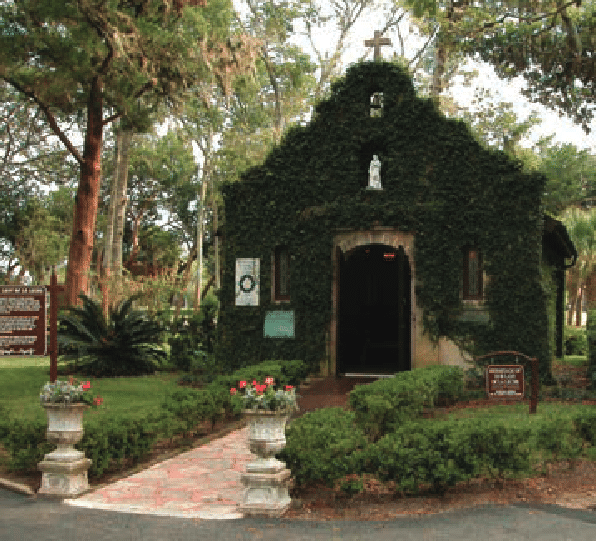
The original chapel of 1620 was probably made of wood and destroyed by fire or hurricane. There is archaeological evidence of a shrine made of coquina stone and oyster shell foundations from around 1678. From the late 17th century until the late 19th century, several other shrines have been built, destroyed, and then reconstructed. On Nov. 14, 1875, Bishop Augustin Verot, the first bishop of the Diocese of St. Augustine, dedicated a reconstructed shrine to Our Lady of La Leche. This shrine, however, was destroyed by hurricane and eventually rebuilt. The present chapel dates from 1915, and it can fit about 30 people at a time. It is built according to the Spanish mission style of the 16th century, and it contains a reconstruction of the original statue of Our Lady of La Leche, which shows the Blessed Mother breastfeeding Baby Jesus.
Some believe the devotion to Our Lady of La Leche can be traced to the Milk Grotto Church in Bethlehem. This grotto might go back to the fourth century, and it is believed to be the site where the Blessed Mother breastfed the baby Jesus. To this day, the Franciscans maintain this shrine church, and many women seeking to have a child have succeeded in conceiving one after praying there.
The more proximate inspiration of the Shrine of Our Lady of La Leche in St. Augustine was a reported miracle during the 1598-1621 reign of King Philip III of Spain. Both mother and child were expected to die when she gave birth, but both were saved from death after the mother prayed before a statue of Our Lady of La Leche. Philip III heard of this miracle, and he had the statue placed in the cathedral.
Devotion to Our Lady of La Leche, therefore, was very strong when the Spanish settled in Florida. As at the Milk Grotto in Bethlehem, many women seeking to conceive pray and light candles in the National Shrine of Our Lady of La Leche in Florida. There have been many reports of children being conceived after these prayers were said as well as reports of safe deliveries of problematic pregnancies. The shrine and the beautiful mission grounds are frequented not only by women seeking to conceive or have a safe delivery. Many other members of the faithful also visit the shrine to honor Our Lady of La Leche.
5. The National Shrine of Our Lady of Champion, Champion, Wisconsin
Wisconsin is a state blessed with some outstanding Marian shrines. In Madison, there is the Shrine of the Schoenstatt Movement, dedicated in 1953 to Mary as Mother Thrice Admirable. There are also three Marian shrines designated by the bishops of Wisconsin as places of pilgrimage to obtain the plenary indulgence for the Year of Mercy. These are: the Basilica of the National Shrine of Mary Help of Christians at Holy Hill; the Shrine of Our Lady of Guadalupe in La Crosse; and the National Shrine of Our Lady of Champion, formerly dedicated as the Shrine of Our Lady of Good Help.
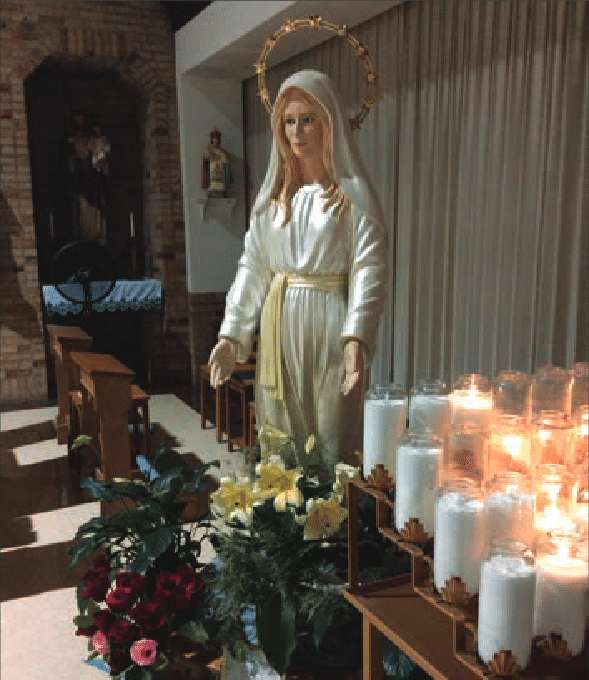
Our Lady of Champion is of special importance because it is the only Marian shrine in the United States located on the site of an approved apparition of the Blessed Virgin Mary. The apparitions began on Oct. 9, 1859 — a year after the apparitions at Lourdes — and the recipient was Adele Brise (1831-1896), a young Belgian woman who had emigrated to Wisconsin in 1855. The Blessed Mother was seen by Adele several times before she revealed who she was and what she wanted. She identified herself as “the Queen of Heaven who prays for the conversion of sinners.” She asked Adele to go to confession and offer her holy Communion for the conversion of sinners. She also asked Adele to teach the children “what they should know for their salvation.” This included “the Sign of the Cross, the catechism, and how to approach the sacraments.”
Adele obeyed this request of the Blessed Mother. At first, she began teaching the children by herself, but she eventually founded a third order community called the Sisters of St. Francis of Assisi (also known as the Sisters of Good Health). A shrine was built to honor Our Lady called the Shrine of Good Help because of Adele’s devotion to Notre Dame de Bon Secours from her native Belgium. Many graces have flowed from this shrine, which was preserved (in a seemingly miraculous way) from the flames of the furious Peshtigo fire of 1871. In 2010, Bishop David Ricken of Green Bay, Wisconsin, declared that the apparitions and locutions given to Adele Brise in 1859 are worthy of belief as supernatural by the Christian faithful.
6. Basilica of Our Lady of San Juan del Valle National Shrine, San Juan, Texas
The origins of this shrine basilica go back to the town of San Juan de Los Lagos near Guadalajara in the Mexican State of Jalisco. In this town a mission church was built with a small image of the Immaculate Conception inside. In 1623, a traveling family of acrobats visited San Juan to give a performance. The youngest daughter of the family lost her balance, fell and died. An Indian woman who helped care for the local church placed the image of the Immaculate Virgin over the child’s body. The child miraculously returned to life. Soon, devotion to the Virgin of San Juan spread throughout Jalisco as well as other parts of what is today Mexico and the United States.
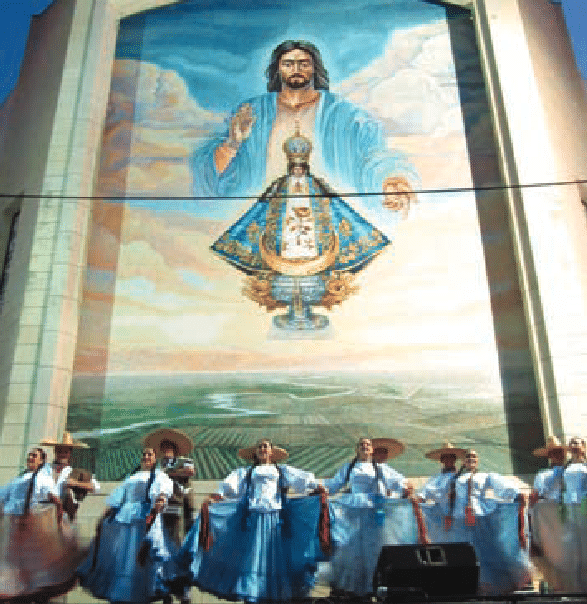
In 1949, Father José Maria Azpiazu, an Oblate of Mary Immaculate, was the pastor of the parish of St. John the Baptist in San Juan, Texas, which is located near McAllen, Texas, in the Rio Grande Valley, just north of the Mexican border. Father Azpiazu wished to spread devotion to Our Lady of San Juan, and he received permission from his bishop to have a reproduction made of the Marian statue venerated in San Juan de Los Angeles in Mexico. At first, this statue was placed in the Church of St. John the Baptist, but construction of a larger church and shrine soon began and was dedicated in 1954.
Devotion to the shrine and the statue grew steadily. On Oct. 23, 1970, however, a tragedy occurred. A special Mass was being offered with 50 priests concelebrating. A small plane crashed into the roof of the shrine and burst into flames. One of the priests, along with a sacristan, rushed to rescue the statue from the spreading fire. But by an apparent miracle, the priests and faithful gathered for Mass in the shrine and the school children in an adjacent cafeteria suffered no injuries. The pilot died.
Although there were damages of some $1.5 million, efforts soon began to rebuild the shrine. Bishop John J. Fitzpatrick of the Diocese of Brownsville, Texas, decided to have a new shrine built just north of the former shrine and the parish church rebuilt on the site of the destroyed sanctuary.
Construction of the new shrine began in 1976, and it was dedicated April 19, 1980. There were some 50,000 people present for the dedication, which had Cardinal Humberto Medeiros along with Bishop Fitzpatrick present. Our Lady of San Juan del Valle was recognized as a national shrine by the U.S. bishops in 1988 and elevated to the status of a minor basilica by Pope St. John Paul II in 1999. It is one of the most visited Marian shrines in the United States with an estimated 1 million visitors a year. The shrine sits on 63 acres, and the basilica can hold more than 3,000 people.

